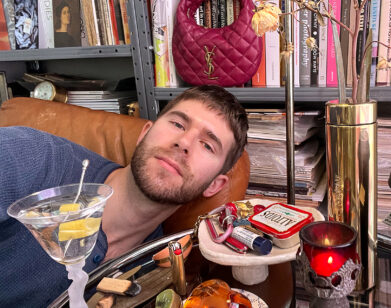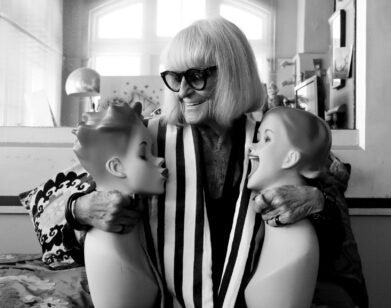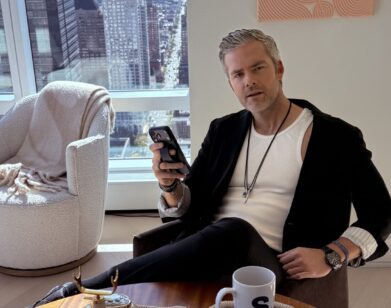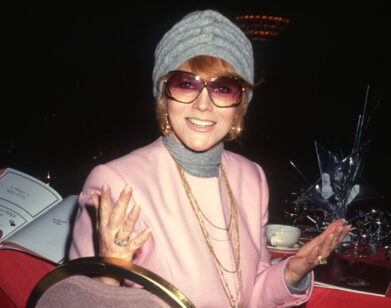Hale Gurland’s Neighborhood Watch
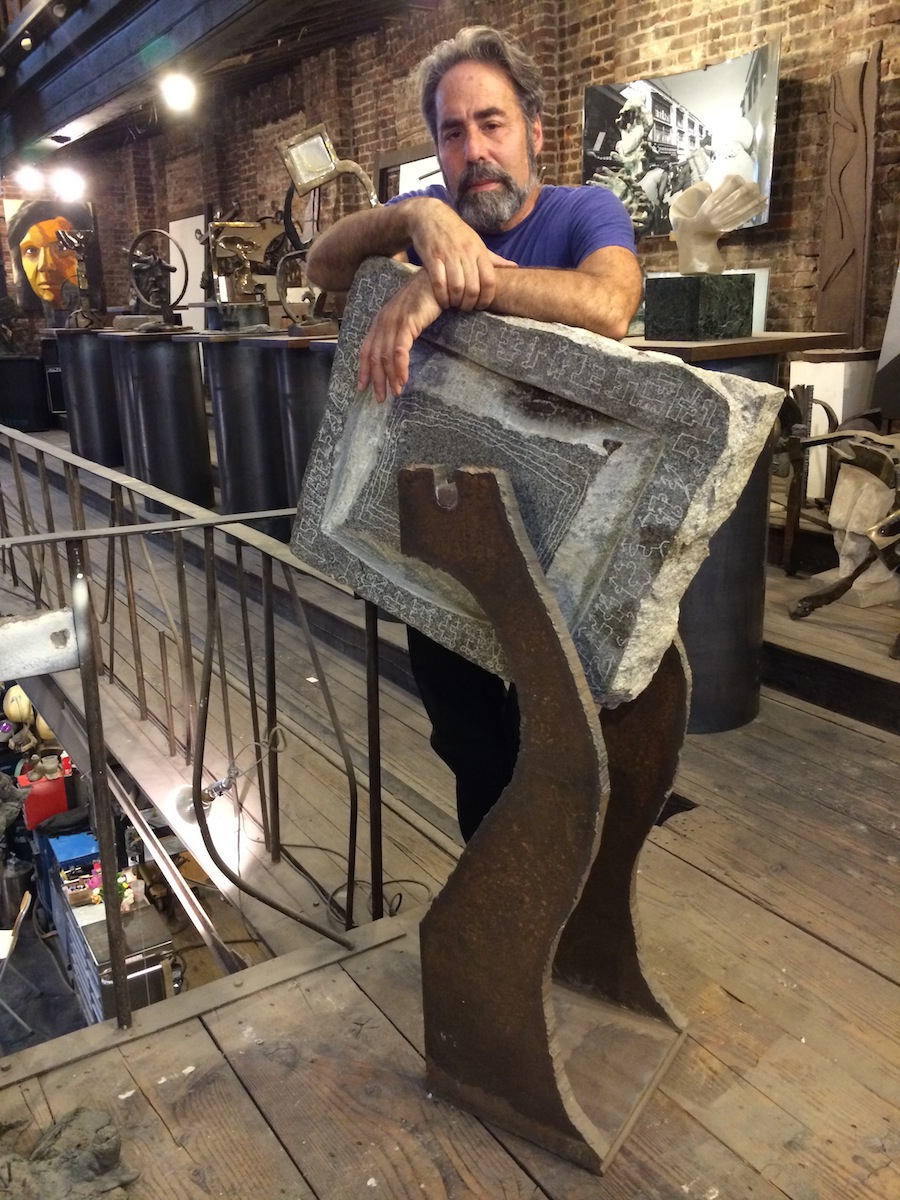
ABOVE: HALE GURLAND
When artist Hale Gurland arrived on the Lower East Side, it was a wild wasteland of creative talent and desperate poverty. There, Gurland found the perfect space to create his large metal sculptures, an abandoned synagogue on Rivington Street. Now, with downtown Manhattan revamped as a decadent drunk tank, Gurland continues to quietly create and nurture a new generation of young kids eager to learn the creative ropes. With University Settlement, The Door, and Alison Fleminger, the Settlement’s Arts Program Curator and Educator, Gurland is hosting an evening of performance called Making Space for Downtown Dreams.
As an internationally shown artist, who once struggled to find a creative home himself, Hale is familiar with the artist’s love/hate relationship with New York. Youth not born to privilege finds it increasingly impossible to create art in an environment of high rents, swank art galleries, and inaccessible, celebrity-studded museum galas. Yet there is still inspiration in the Lower East Side streets, and these kids explore their urban jungle through vogue-ing, song, and dance. We spoke with Hale in his gorgeous, soaring synagogue studio space about the mad, beautiful old Lower East Side, dentists, social consciousness, the importance of creating, and why calling yourself an artist is arrogant bullshit.
ROYAL YOUNG: What was the role arts played in the Lower East Side when you first got here and how has that changed?
HALE GURLAND: [laughs] It’s not going to be good.
YOUNG: [laughs] I know, but give it to me.
GURLAND: In the late ’70s, I was in SoHo, like a lot of artists. I was renting a place on Wooster Street above the AIR Gallery, which was a lesbian gallery at the time. Next door was the gay firehouse gallery. At night, it was a riot. They showed really interesting work. Rents went up, so I had to move. I went to buy cheap new shoes on Orchard Street, and walking back I passed the synagogue on Rivington. It had a crumpled For Sale sign. People were going inside the building because the doors were out, junkies were shooting up. I walked in, and the place looked like Dresden after the bombs. Rain was coming through the roof. It looked like they had a service, and everybody left. It was really cool. I forgot about the shoes.
My friend, the sculptor John Sanders, bought the corner building. It was called The Madhouse. It was an SRO, and they rented to people who were out of their minds shooting each other, throwing each other out of the building, wacko with drugs. It was the late ’70s.
YOUNG: The University Settlement across the street has been here since the late 1800s.
GURLAND: It’s been here forever. I was doing things with them, giving presents to the kids since I moved in. They started the first kindergarten in America. I began doing sculpture with the kids.
YOUNG: What inspired you to get involved?
GURLAND: The kids were vibrant, they were interesting and fresh. They were coming from a diverse neighborhood, they were black, Dominican, Colombian, Chinese; and they were desperate, like most kids, to learn. The ghetto was changing from the Irish, Italians, and Jews. This was interesting.
When I was a kid, my father was an army dental surgeon. After my father died, I didn’t see a dentist for 30 years. He used to say, “A real man shouldn’t need Novocain.” I was three years old. He also taught me to give back to community. We went down to the Selma march when I was a kid. His grandmother was black from Ethiopia, so he was kind of dark. We couldn’t get on the front of a bus in Georgia. I remember this as a little kid, sitting on the colored side of the diner and we couldn’t use the bathroom at the gas station. The South was horrible in the ’50s. My father taught me I was responsible for everyone around me.
YOUNG: Do you think having a community is an integral part of art?
GURLAND: Yes. The Door, which is part of University Settlement, has art programs for kids without homes; they do a lot of music and photography and performance art. This also covers mental health and physical health. The arts have always been a problem with money.
YOUNG: Why do you think that is?
GURLAND: Because it seems like the least necessary thing. You need reading, writing, and arithmetic to get the job.
YOUNG: I think that is an outdated mode of thinking.
GURLAND: Oh, it’s totally outdated.
YOUNG: It keeps people down. Because you’re like here are the tools for you to be a cog in this larger social machine, whereas art lets you see outside of that.
GURLAND: Art teaches how to look at that world. You teach people how to move and dance, they feel comfortable and comport themselves. You teach them how to express with their whole body, you have a relationship with somebody else, how do you touch them? Why do you touch them? How do you stand? How do you sit? How do you eat? The things we need to learn are dance, movement, speech. These are taught through art and communication. Art looks like an accessory, but they are extremely important.
YOUNG: Being creative is a mindset you can apply to everything?
GURLAND: Yes, you need to be able to think out of the box. Understanding is an emotion and a feeling.
YOUNG: Do you think anyone has the potential to be an artist? I could be a carpenter with artistry, I could wash dishes with artistry.
GURLAND: Artist is the wrong term today. You could be a photographer, painter, singer, or dancer, but not an artist. You can’t say you’re an artist; somebody else has to say it. Being an artist is mastering something. If you’re a physician and a patient calls you an artist, that is the highest compliment. That’s the top of anything. You may do something well, but when do you take it to an art form? To say you’re an artist is arrogant bullshit. I’m a painter. To be an artist you have to prove it and it might take 100 years.
There’s people who cook and then there are people who create food with bigger pleasure and a memory and a place to go. That’s an artist. They should teach that in all the schools. Economics through art. You can teach all of it.
YOUNG: Now the mentality is that people don’t want to be an artist, they just want to be rich and famous.
GURLAND: They want their dick size bigger, their tits bigger, and to have more money and more power. Better shoes, a fancier watch, a nicer car, they want the things to be accepted. It’s a very natural human condition, but when we moved down to the Lower East Side it was not to live in New York and be rich and show off, it was to have a fucking place to do our goddamn art. That was it. All the artists knew each other and we’d meet at an old bar where all the pimps, prostitutes, and junkies went. We got a 50-cent Pabst and a burger for a buck. Some of the guys would even buy art with the money they made selling fucking drugs. It was fine.
MAKING SPACE FOR DOWNTOWN DREAMS WILL TAKE PLACE THIS EVENING AT UNIVERSITY SETTLEMENT, NEW YORK. FOR MORE INFORMATION, PLEASE CLICK HERE.

